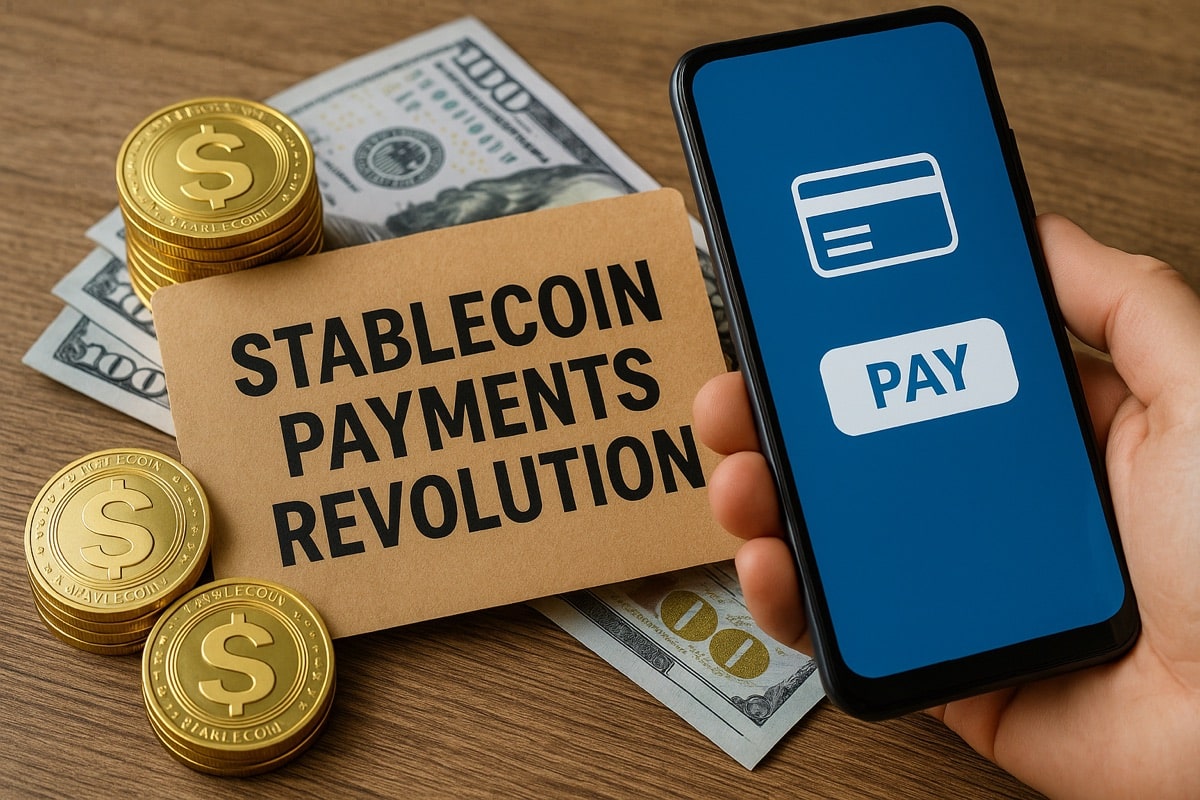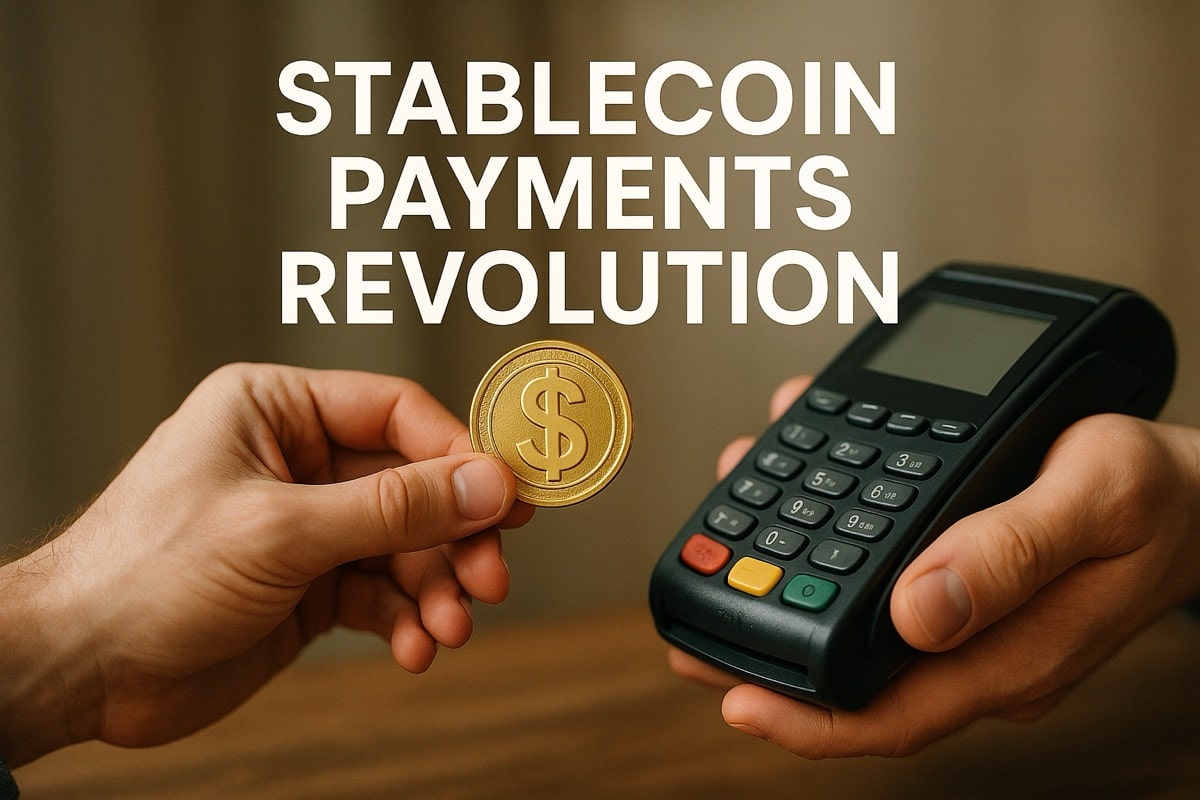Just as stablecoin settlements are gaining momentum in the B2B segment, payment service providers are taking very different paths in the stablecoin payments revolution, with strategies ranging from bold integration to cautious observation. Here are four main stablecoin adoption archetypes shaping the next phase of digital payments.

Why Stablecoins Matter for Every PSP
This year, stablecoin circulation hit its all-time high record. In September 2025 alone, monthly adjusted transaction volume reached an impressive $1.25 trillion, demonstrating sustained momentum that is independent of speculative cryptocurrency trading. Over the past year, these digital tokens handled a total transaction volume of $46 trillion, marking a 106% year-over-year increase, noted a recent A16z report.
After adjusting to remove bot-driven or artificial activity, stablecoins processed roughly $9 trillion over the past 12 months — an 87% increase from the previous year. This volume now exceeds half of Visa’s total payment volume and is more than five times that of PayPal.
As stablecoins quietly evolve from crypto-native assets into practical settlement tools, payment service providers (PSPs) can no longer afford to ignore their rise. Global stablecoin payment volumes surpassed $94 billion between 2023 and 2025, with B2B transactions now outpacing peer-to-peer flows, reaching an annualised $36 billion and growing more than 30× in just two years.
The trend is particularly pronounced in the Asia Pacific region (APAC), which accounts for nearly 38% of global stablecoin payment activity, driven by cross-border business settlements, while Latin America leads in remittance-based and peer flows.
For PSPs, this shift signals a new competitive dynamic: the infrastructure formerly underpinning niche crypto payments is now maturing into a viable stablecoin settlement layer for regular commerce.
It is faster than traditional payment rails, programmable, and increasingly regulated. The question is no longer whether stablecoins will impact payment models, but how PSPs will adapt to integrate or compete with them.
Payment Service Provider Response to Stablecoin Surge
PSPs are responding to this emerging stablecoin landscape in markedly different ways. Some are early adopters, fully integrating stablecoin settlement into their platforms and experimenting with cross-border B2B flows to offer faster, cheaper, and programmable payments.
Others are cautiously experimenting, partnering with blockchain infrastructure providers or running pilot programs, but wait with full onboarding so far, while monitoring regulatory developments.
A third group consists of observers, cautiously evaluating the technology and market demand before committing resources. They pay attention to industry developments, conduct their own research, yet linger on legacy payment rails.
Finally, there are fervent opponents of stablecoins and all things crypto. Such PSPs continue to rely exclusively on traditional fiat rails, viewing stablecoins as a niche or high-risk innovation.
Understanding these main archetypes is crucial for positioning a stablecoin strategy, as crypto-native PSPs like BitPay, MoonPay, or PlasmaPay, or white label crypto payment gateways are already capturing merchants and customers in segments where traditional providers hesitate to move.
Active Stablecoin Adopters Redefining Payment Infrastructure
At the forefront of the stablecoin revolution are the innovators — PSPs actively embedding blockchain rails into their core systems. There are numerous examples of such bold visionaries, both among small-scale startups and global payment giants.
Visa has expanded its stablecoin and blockchain integrations to facilitate settlement transactions for issuers and acquirers, reflecting how mainstream networks now view stablecoins as operational assets rather than experiments.
Mastercard is also deepening its play, reportedly in a rivalry with Coinbase over a potential $1.5 – $2.5 billion acquisition of stablecoin infrastructure startup BVNK — a move that could cement its position in blockchain settlement.
Stripe has significantly deepened its involvement as well, extending stablecoin payments to include subscription and recurring billing, bringing Web3 functionality into everyday commerce, and introducing Open Issuance — a platform that lets businesses launch their own stablecoin in days.
Meanwhile, Finastra’s collaboration with Circle enables banks and financial institutions to perform cross-border settlements in USDC, bridging traditional finance with blockchain-based liquidity.
For these innovators, stablecoins are less about speculation and more about infrastructure enabling faster, cheaper, and programmable global payments.
Explorers Testing Real-World Utility
The second group, which can be labelled as the experimenters, consists of established players cautiously rolling out use cases to validate stablecoin efficiency in specific corridors or services.
Thus, Western Union, long synonymous with cross-border remittances, recently announced plans to accelerate stablecoin use to improve speed and lower costs for international transfers.
Revolut, another early mover, offers USDC trade through Revolut Pay, enabling users to purchase stablecoins with ease and through multiple payment methods integrated into its ecosystem, facilitating fiat-to-crypto transactions. With its latest MiCA license achievement, media ponder the possibility of the neobank launching its own stablecoin eventually.
Other PSPs in this category are conducting pilots in merchant payouts, treasury settlement, and cross-border FX reduction, often in partnership with blockchain providers. Their goal is to quantify real-world ROI while staying flexible enough to pivot as regulation and technology evolve.

Observers Waiting for Regulatory and Market Clarity
The strategic onlookers include PSPs that recognize the potential of stablecoin payments but are holding off on deployment until regulatory, security, and interoperability questions are settled.
Many large regional and global PSPs fall into this category, closely monitoring progress from leaders like Visa, Mastercard, and Circle to assess when and how to enter the market. Adyen, for instance, has explored blockchain settlement concepts but remains conservative on stablecoin integration, emphasizing compliance and risk management before scaling any pilots. Similarly, Worldpay (FIS), once active in crypto merchant services, has slowed its efforts, awaiting clearer global standards.
They’re particularly attentive to stablecoin compliance frameworks, the rollout of MiCA in Europe, and forthcoming U.S. legislation that could standardize how fiat-backed tokens operate. For them, strategic timing may prove as valuable as early adoption.
Risk-Averse PSP Group Held Back by Regulation or Risk Appetite
Finally, stablecoin opponents or PSPs restricted in their opportunities, a smaller but notable segment, include PSPs and fintech giants that have paused or shelved stablecoin initiatives due to either regulatory pushback or risk concerns.
Chinese regulators, for example, have reportedly instructed several major tech and payment firms such as Ant Group and JD.com to halt stablecoin projects in Hong Kong, citing financial stability and capital control issues. These companies may be focusing on central bank digital currency (CBDC) pilots in these circumstances, which limits their participation in open stablecoin ecosystems.
Some bank-owned PSPs (like those tied to European clearing networks) have taken a publicly critical stance toward stablecoins, arguing they threaten monetary sovereignty and fragment liquidity. At the same time, they advocate for regulated CBDCs or tokenized deposits as safer alternatives.
Crypto Natives Continuously Boost Their Stablecoin Offerings
Meanwhile, crypto-native firms such as Coinbase, Coinflow, and others are doubling down on new issuance, merchant services, and funding rounds, further widening the gap between agile blockchain-first players and traditional PSPs constrained by regulation.
Within crypto native cohort, stablecoin payment infrastructure is rapidly evolving. It is often complemented by AI-driven fraud prevention and blockchain proof-of-delivery services. Moreover, today we see an increasing number of zero-fee stablecoin swap solutions such as PENNY, recently launched by B2C2, or Bitget Wallet integration of a cross-chain bridge to Plasma, a stablecoin-native blockchain, simplifying access to zero-fee USDT transactions.
Final Thoughts
Across these four archetypes, the stablecoin payments ecosystem is clearly fragmented but accelerating towards mainstream adoption. PSPs that actively integrate stablecoins, experimenting with cross-border settlement, subscription payments, and merchant payouts, are outnumbering the vocal sceptics, while crypto-native firms continue to push innovation at a pace few traditional providers can match.
Meanwhile, cautious or restricted PSPs are monitoring regulatory clarity and market adoption, ensuring compliance but risking lost opportunity in high-growth B2B and cross-border stablecoin flows.
For PSPs navigating this complex landscape, the strategic imperative is clear: evaluate stablecoin adoption not as optional speculation, but as a potential operational rail for future-proof payments, balancing innovation, risk, and regulatory readiness.









